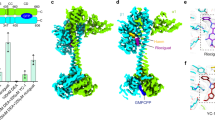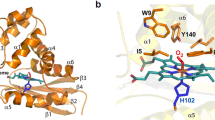Abstract
Soluble guanylate cyclases (sGCs) function as heme sensors that selectively bind nitric oxide (NO), triggering reactions essential to animal physiology. Recent discoveries place sGCs in the H-NOX family (heme nitric oxide/oxygen-binding domain), which includes bacterial proteins from aerobic and anaerobic organisms. Some H-NOX proteins tightly bind oxygen (O2), whereas others show no measurable affinity for O2, providing the basis for selective NO signaling in aerobic cells. Using a series of wild-type and mutant H-NOXs, we established a molecular basis for ligand discrimination. A distal pocket tyrosine is requisite for O2 binding in the H-NOX family. These data suggest that sGC uses a kinetic selection against O2; we propose that the O2 dissociation rate in the absence of this tyrosine is fast and that a stable O2 complex does not form.
This is a preview of subscription content, access via your institution
Access options
Subscribe to this journal
Receive 12 print issues and online access
$259.00 per year
only $21.58 per issue
Buy this article
- Purchase on Springer Link
- Instant access to full article PDF
Prices may be subject to local taxes which are calculated during checkout



Similar content being viewed by others
References
Denninger, J.W. & Marletta, M.A. Guanylate cyclase and the NO/cGMP signaling pathway. Acta Biochem. Biophys. 1411, 334–350 (1999).
Iyer, L.M., Anantharaman, V. & Aravind, L. Ancient conserved domains shared by animal soluble guanylyl cyclases and bacterial signaling proteins. BMC Genomics 4, 5 (2003).
Karow, D.S. et al. Spectroscopic characterization of the soluble guanylate cyclase-like heme domains from Vibrio cholerae and Thermoanaerobacter tengcongensis . Biochemistry 43, 10203–10211 (2004).
Pellicena, P. et al. Crystal structure of an oxygen-binding heme domain related to soluble guanylate cyclases. Proc. Natl. Acad. Sci. USA 101, 12854–12859 (2004).
Mathews, A.J. & Olson, J.S. Assignment of rate constants for O2 and CO binding to α-subunit and β-subunit within R-state and T-state human hemoglobin. Methods Enzymol. 232, 363–386 (1994).
Draghi, F. et al. Controlling ligand binding in myoglobin by mutagenesis. J. Biol. Chem. 277, 7509–7519 (2002).
Olson, J.S. & Phillips, G.N. Kinetic pathways and barriers for ligand binding to myoglobin. J. Biol. Chem. 271, 17593–17596 (1996).
Springer, B.A., Sligar, S.G., Olson, J.S. & Phillips, G.N. Mechanisms of ligand recognition in myoglobin. Chem. Rev. 94, 699–714 (1994).
Aono, S. et al. Resonance Raman and ligand binding studies of the oxygen-sensing signal transducer protein HemAT from Bacillus subtilis . J. Biol. Chem. 277, 13528–13538 (2002).
Kundu, S., Trent, J.T. & Hargrove, M.S. Plants, humans and hemoglobins. Trends Plant Sci. 8, 387–393 (2003).
Wittenberg, J.B., Bolognesi, M., Wittenberg, B.A. & Guertin, M. Truncated hemoglobins: a new family of hemoglobins widely distributed in bacteria, unicellular eukaryotes, and plants. J. Biol. Chem. 277, 871–874 (2002).
Deinum, G., Stone, J.R., Babcock, G.T. & Marletta, M.A. Binding of nitric oxide and carbon monoxide to soluble guanylate cyclase as observed with resonance raman spectroscopy. Biochemistry 35, 1540–1547 (1996).
Oertling, W.A., Kean, R.T., Wever, R. & Babcock, G.T. Factors affecting the iron oxygen vibrations of ferrous oxy and ferryl oxo heme-proteins and model compounds. Inorg. Chem. 29, 2633–2645 (1990).
Phillips, G.N. et al. Bound CO is a molecular probe of electrostatic potential in the distal pocket of myoglobin. J. Phys. Chem. B 103, 8817–8829 (1999).
Nioche, P. et al. Femtomolar sensitivity of a NO sensor from Clostridium botulinum . Science 306, 1550–1553 (2004).
Zhao, Y., Brandish, P.E., Ballou, D.P. & Marletta, M.A. A molecular basis for nitric oxide sensing by soluble guanylate cyclase. Proc. Natl. Acad. Sci. USA 96, 14753–14758 (1999).
Gray, J.M. et al. Oxygen sensation and social feeding mediated by a C. elegans guanylate cyclase homologue. Nature 430, 317–322 (2004).
Morton, D.B. Atypical soluble guanylyl cyclases in Drosophila can function as molecular oxygen sensors. J. Biol. Chem. 279, 50651–50653 (2004).
Quillin, M.L. et al. Structural and functional effects of apolar mutations of the distal valine in myoglobin. J. Mol. Biol. 245, 416–436 (1995).
Hvitved, A.N., Trent, J.T., Premer, S.A. & Hargrove, M.S. Ligand binding and hexacoordination in Synechocystis hemoglobin. J. Biol. Chem. 276, 34714–34721 (2001).
Hargrove, M.S. et al. Crystal structure of a nonsymbiotic plant hemoglobin. Structure Fold Des. 8, 1005–1014 (2000).
Pesce, A. et al. Human brain neuroglobin structure reveals a distinct mode of controlling oxygen affinity. Structure 11, 1087–1095 (2003).
Gong, W., Hao, B. & Chan, M.K. New mechanistic insights from structural studies of the oxygen-sensing domain of Bradyrhizobium japonicum FixL. Biochemistry 39, 3955–3962 (2000).
Gibson, Q.H. & Smith, M.H. Rates of reaction of Ascaris haemoglobins with ligands. Proc. R. Soc. Lond. Biol. 163, 206–214 (1965).
Hargrove, M.S. et al. Characterization of recombinant soybean leghemoglobin a and apolar distal histidine mutants. J. Mol. Biol. 266, 1032–1042 (1997).
Kiger, L. et al. Trematode hemoglobins show exceptionally high oxygen affinity. Biophys. J. 75, 990–998 (1998).
Gilles-Gonzalez, M.A. et al. Heme-based sensors, exemplified by the kinase FixL, are a new class of heme protein with distinctive ligand binding and autoxidation. Biochemistry 33, 8067–8073 (1994).
Chang, A.L. et al. Phosphodiesterase A1, a regulator of cellulose synthesis in Acetobacter xylinum, is a heme-based sensor. Biochemistry 40, 3420–3426 (2001).
Dmochowski, I.J., Winkler, J.R. & Gray, H.B. Enantiomeric discrimination of Ru-substrates by cytochrome P450cam. J. Inorg. Biochem. 81, 221–228 (2000).
Moore, E.G. & Gibson, Q.H. Cooperativity in the dissociation of nitric oxide from hemoglobin. J. Biol. Chem. 251, 2788–2794 (1976).
Kharitonov, V.G., Sharma, V.S., Magde, D. & Koesling, D. Kinetics of nitric oxide dissociation from five- and six-coordinate nitrosyl hemes and heme proteins, including soluble guanylate cyclase. Biochemistry 36, 6814–6818 (1997).
Acknowledgements
The Laboratory Directed Research and Development (LDRD) Fund from Lawrence Berkeley National Lab provided funding to M.A.M., the US National Science Foundation to S.H.H. and the Ruth L. Kirschstein National Research Service Award to E.M.B. (F32GM069302). We very gratefully acknowledge W. Belliston-Bittner, B. Leigh, J. Winkler and H. Gray at the Beckman Institute Laser Resource Center at the California Institute of Technology for their essential help in measuring oxygen association rates. We also thank J.H. Davis, P. Pellicena and J. Kuriyan at the University of California, Berkeley, as well as J. Dixon at the University of California, San Diego, and D. Ballou at the University of Michigan for helpful discussions.
Author information
Authors and Affiliations
Corresponding author
Ethics declarations
Competing interests
The authors declare no competing financial interests.
Rights and permissions
About this article
Cite this article
Boon, E., Huang, S. & Marletta, M. A molecular basis for NO selectivity in soluble guanylate cyclase. Nat Chem Biol 1, 53–59 (2005). https://doi.org/10.1038/nchembio704
Received:
Accepted:
Published:
Issue Date:
DOI: https://doi.org/10.1038/nchembio704
This article is cited by
-
Ultrafast dynamics of heme distortion in the O2-sensor of a thermophilic anaerobe bacterium
Communications Chemistry (2021)
-
A novel thermophilic hemoprotein scaffold for rational design of biocatalysts
JBIC Journal of Biological Inorganic Chemistry (2018)
-
Molecular Cloning and Characterization of a Guanylyl Cyclase, PnGC-1, Involved in Light Signaling in Pharbitis nil
Journal of Plant Growth Regulation (2009)
-
Molecular steps in sGC activation
BMC Pharmacology (2007)
-
Complete genome sequence of the fish pathogen Flavobacterium psychrophilum
Nature Biotechnology (2007)



